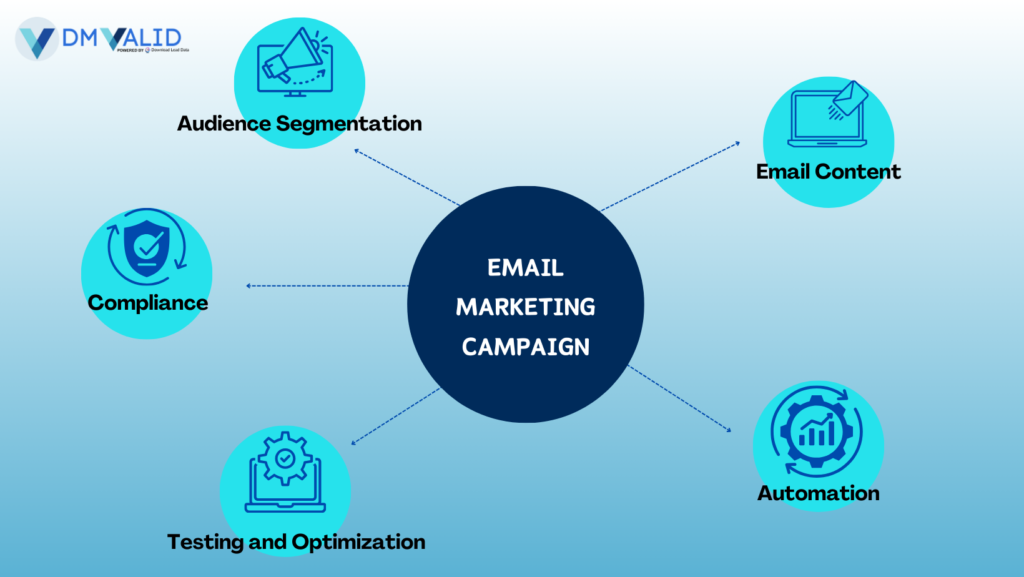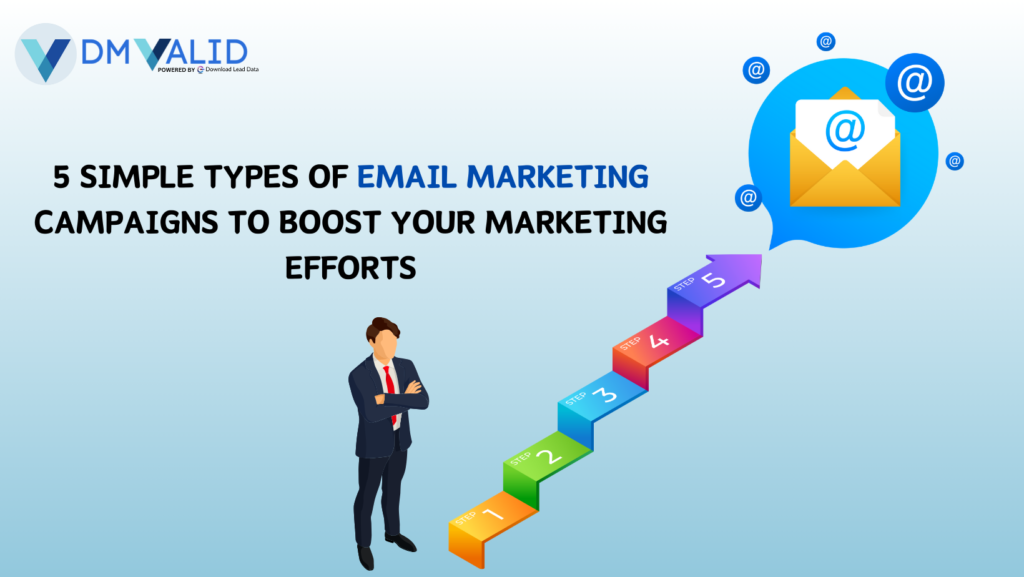An email marketing campaign is a series of individual emails sent over some time with a specific purpose, be it to promote a product, share news, or nurture relationships with customers.
Key Components of an Email Marketing Campaign:

1. Audience Segmentation:
Targeting: Segment your email list based on demographics, behavior, purchase history, or engagement level. So your messages are relevant to the recipient.
Personalization: Personalise your content for individual preferences to boost open rates and engagement.
2. Email Content:
Subject Line: Write a subject line that grabs attention and gets the recipient to open the email.
Body Content: Keep it short, valuable, and aligned to your campaign goals. Mix of text, images, and clear CTAs.
Design: A mobile-friendly design is key. Make sure your emails are easy to read and navigate on all devices.
3. Automation:
Use email marketing platforms like Mailchimp, HubSpot, or MoEngage to automate the sending of emails based on user actions or pre-scheduled times. Automation helps to streamline your campaign and follow up in time.
4. Testing and Optimization:
A/B Testing: Test subject lines, content, CTAs and send times to see what works best with your audience.
Analytics: Track open rates, CTR, conversion rates, and other metrics to measure the success of your campaign and make data-driven decisions.
5. Compliance:
Make sure your emails comply with regulations like GDPR or CAN-SPAM. This includes getting consent from recipients and providing an unsubscribe link.
Benefits of Email Marketing:
Cost-Effective: High ROI with low costs.
Measurable Results: Track and measure performance metrics to improve future campaigns.
Direct Communication: Communicate directly with your audience in a personal way.
Six simple types of email marketing campaigns that can significantly improve your marketing plan:
Welcome Emails
Purpose: Welcome new subscribers to your brand.
Key Elements:
- A warm and engaging message to thank the subscriber for joining.
- Introduction to your brand’s values, products or services.
- Clear CTA, to visit your website or follow you on social media.
Why It Works: Sets the tone for future communications and makes a good first impression.
Promotional Emails
Purpose: Drive sales by highlighting special offers, discounts, or limited-time deals.
Key Elements:
- A compelling subject line that emphasizes the offer.
- Eye-catching visuals of the products or services on sale.
- Clear CTAs encouraging recipients to shop or claim the offer.
Why It Works: Creates urgency and encourages immediate action, leading to increased conversions.
Newsletter Emails
Purpose: Keep your audience informed and engaged with regular updates.
Key Elements:
- A mix of content such as company news, blog posts, industry insights, and upcoming events.
- Personalization based on subscriber interests.
- Consistent delivery schedule (e.g., weekly or monthly).
Why It Works: Builds trust and keeps your brand top-of-mind by delivering value regularly.
Abandoned Cart Emails
Purpose: Recover lost sales by reminding customers about items left in their shopping cart.
Key Elements:
- A friendly reminder of the items still in the cart.
- A sense of urgency (e.g., “Your cart is about to expire”).
- Optionally, include a discount code or special offer to incentivize the purchase.
Why It Works: Encourages customers to complete their purchase, reducing cart abandonment rates.
Re-engagement Emails
Purpose: Reconnect with inactive subscribers and bring them back into the fold.
Key Elements:
- Acknowledgment of the subscriber’s inactivity with a gentle nudge to re-engage.
- Special offers or personalized recommendations to reignite interest.
- Option to update email preferences to receive more relevant content.
Why It Works: Revives relationships with subscribers who might have lost interest, helping to retain them.

CTA Buttons
Purpose: It is used as clearly communicate value, and guide users towards taking action ultimately enhancing user experience and upscale conversions,
Types of CTAs:
- Image: It is a path for explaining value offering and promotion.
- Button: Help the user to navigate to the value proposition.
- Anchor: Make sure to place it directly and clearly to know visitors what they are clicking on.
The Main Takeaways: We will list some of the main things to follow the CTA takeaway to add more chances for an increased percentage.
1. Action taking tone:
Apply second-person verbs, action-oriented like sign me up, get started, find out more, learn more, download now.
2. Keep it short
Let message stand out loud and clear within 80 – 120 to the point message.
3. Clear Value Addition:
Show them what will happen if they click that option.
4. Good Design:
It shouldn’t blend with the website, it should stand out from the rest.
5. Time bounded:
Offer time propositions such as limited period, and limited time.
6. Make sure to know the audience:
Either it is optimized for leads, customers, audience types
Conclusion:
As we Have explained through email marketing increase business by engaging customers through welcome messages, special offers, newsletters, cart reminders, and re-engagement emails, fostering stronger relationships and driving action, CTA buttons with Simple, effective, and impactful.
Content Writer at DM Valid
Asifa Khanum is a Content Specialist at DM Valid. I fulfilled roles in marketing that shaped her interest in finding innovative solutions to modern-day problems.


